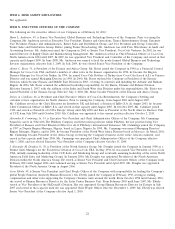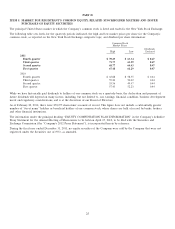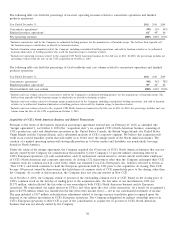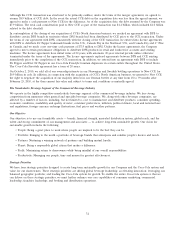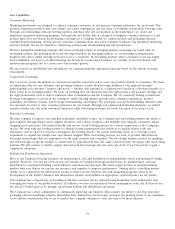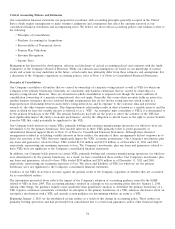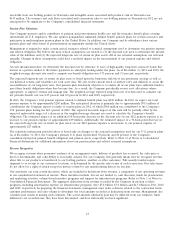Coca Cola 2011 Annual Report Download - page 33
Download and view the complete annual report
Please find page 33 of the 2011 Coca Cola annual report below. You can navigate through the pages in the report by either clicking on the pages listed below, or by using the keyword search tool below to find specific information within the annual report.Although the CCE transaction was structured to be primarily cashless, under the terms of the merger agreement, we agreed to
assume $8.9 billion of CCE debt. In the event the actual CCE debt on the acquisition date was less than the agreed amount, we
agreed to make a cash payment to New CCE for the difference. As of the acquisition date, the debt assumed by the Company was
$7.9 billion. The total cash consideration paid to New CCE as part of the transaction was $1.4 billion, which included $1.0 billion
related to the debt shortfall.
In contemplation of the closing of our acquisition of CCE’s North American business, we reached an agreement with DPS to
distribute certain DPS brands in territories where DPS brands had been distributed by CCE prior to the CCE transaction. Under
the terms of our agreement with DPS, concurrently with the closing of the CCE transaction, we entered into license agreements
with DPS to distribute Dr Pepper trademark brands in the U.S., Canada Dry in the Northeast U.S., and Canada Dry and C’ Plus
in Canada, and we made a net one-time cash payment of $715 million to DPS. Under the license agreements, the Company
agreed to meet certain performance obligations to distribute DPS products in retail and foodservice accounts and vending
machines. The license agreements have initial terms of 20 years, with automatic 20-year renewal periods unless otherwise
terminated under the terms of the agreements. The license agreements replaced agreements between DPS and CCE existing
immediately prior to the completion of the CCE transaction. In addition, we entered into an agreement with DPS to include
Dr Pepper and Diet Dr Pepper in our Coca-Cola Freestyle fountain dispensers in certain outlets throughout the United States.
The Coca-Cola Freestyle agreement has a term of 20 years.
On October 2, 2010, we sold all of our ownership interests in our Norwegian and Swedish bottling operations to New CCE for
$0.9 billion in cash. In addition, in connection with the acquisition of CCE’s North American business, we granted to New CCE
the right to negotiate the acquisition of our majority interest in our German bottler at any time from 18 to 39 months after
February 25, 2010, at the then current fair value and subject to terms and conditions as mutually agreed.
The Nonalcoholic Beverage Segment of the Commercial Beverage Industry
We operate in the highly competitive nonalcoholic beverage segment of the commercial beverage industry. We face strong
competition from numerous other general and specialty beverage companies. We, along with other beverage companies, are
affected by a number of factors, including, but not limited to, cost to manufacture and distribute products, consumer spending,
economic conditions, availability and quality of water, consumer preferences, inflation, political climate, local and national laws
and regulations, foreign currency exchange fluctuations, fuel prices and weather patterns.
Our Objective
Our objective is to use our formidable assets — brands, financial strength, unrivaled distribution system, global reach, and the
talent and strong commitment of our management and associates — to achieve long-term sustainable growth. Our vision for
sustainable growth includes the following:
• People: Being a great place to work where people are inspired to be the best they can be.
• Portfolio: Bringing to the world a portfolio of beverage brands that anticipates and satisfies people’s desires and needs.
• Partners: Nurturing a winning network of partners and building mutual loyalty.
• Planet: Being a responsible global citizen that makes a difference.
• Profit: Maximizing return to shareowners while being mindful of our overall responsibilities.
• Productivity: Managing our people, time and money for greatest effectiveness.
Strategic Priorities
We have four strategic priorities designed to create long-term sustainable growth for our Company and the Coca-Cola system and
value for our shareowners. These strategic priorities are driving global beverage leadership; accelerating innovation; leveraging our
balanced geographic portfolio; and leading the Coca-Cola system for growth. To enable the entire Coca-Cola system so that we
can deliver on these strategic priorities, we must further enhance our core capabilities of consumer marketing; commercial
leadership; franchise leadership; and bottling and distribution operations.
31



